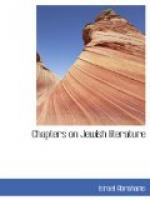Steinschneider.—Jewish Literature, p. 174.
BERACHYA HA-NAKDAN.
J. Jacobs.—Jews of Angevin England, pp. 165 seq., 278.
A. Neubauer.—J.Q.R., II, p. 520.
ZABARA.
I. Abrahams.—J.Q.R., VI, p. 502
(with English translation
of the Book of Delight).
CHAPTER XVI
MOSES NACHMANIDES
French and Spanish Talmudists.—The Tossafists, Asher of Speyer, Tam, Isaac of Dompaire, Baruch of Ratisbon, Perez of Corbeil.—Nachmanides’ Commentary on the Pentateuch.—Public controversies between Jews and Christians.
Nachmanides was one of the earliest writers to effect a reconciliation between the French and the Spanish schools of Jewish literature. On the one side, his Spanish birth and training made him a friend of the widest culture; on the other, he was possessed of the French devotion to the Talmud. Moses, the son of Nachman (Nachmanides, Ramban, 1195-1270), Spaniard though he was, says, “The French Rabbis have won most Jews to their view. They are our masters in Talmud, and to them we must go for instruction.” From the eleventh to the fourteenth century, a French school of Talmudists occupied themselves with the elucidation of the Talmud, and from the “Additions” (Tossafoth) which they compiled they are known as Tossafists. The Tossafists were animated with an altogether different spirit from that of the Spanish writers on the Talmud. But though their method is very involved and over-ingenious, they display so much mastery of the Talmud, such excellent discrimination, and so keen a critical insight, that they well earned the fame they have enjoyed. The earliest Tossafists were the family and pupils of Rashi, but the method spread from Northern France to Provence, and thence to Spain. The most famous Tossafists were Isaac, the son of Asher of Speyer (end of the eleventh century); Tam of Rameru (Rashi’s grandson); Isaac the Elder of Dompaire (Tam’s nephew); Baruch of Ratisbon; and Perez of Corbeil.
Nachmanides’ admiration for the French method—a method by no means restricted to the Tossafists—did not blind him to its defects. “They try to force an elephant through the eye of a needle,” he sarcastically said of some of the French casuists. Nachmanides thus possessed some of the independence characteristic of the Spanish Jews. He also shared the poetic spirit of Spain, and his hymn for the Day of Atonement is one of the finest products of the new-Hebrew muse. The last stanzas run thus:
Thine is the love, O God,
and thine the grace,
That holds the sinner in its
mild embrace;
Thine the forgiveness, bridging
o’er the space
’Twixt man’s
works and the task set by the King.
Unheeding all my sins, I cling
to thee!
I know that mercy shall thy
footstool be:
Before I call, O do thou answer
me,
For nothing dare
I claim of thee, my King!




